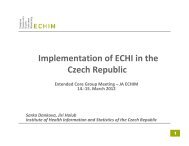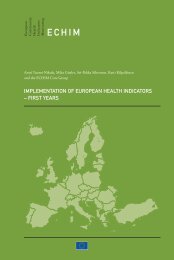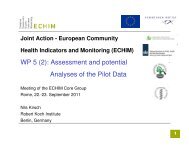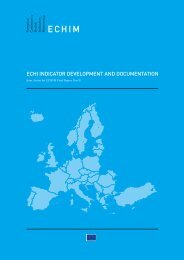INDICATORS
ECHIM Final Report
ECHIM Final Report
Create successful ePaper yourself
Turn your PDF publications into a flip-book with our unique Google optimized e-Paper software.
69. HOSPITAL DAYCASE/IN-PATIENT DISCHARGE RATIO, LIMITED DIAGNOSES<br />
Definition: The indicator is defined as the ratio of the number of hospital daycases from all<br />
hospitals, to the number of hospital inpatient discharges from all hospitals, during the given<br />
calendar year. Calculated and presented by the categories of the International Shortlist for<br />
Hospital Morbidity Tabulation (ISHMT).<br />
Calculation: The indicator is calculated as the total number of hospital daycases from all<br />
hospitals during the given calendar year, divided by the total number of hospital in-patient<br />
discharges from all hospitals during the given calendar year. Calculated by the categories of<br />
the International Shortlist for Hospital Morbidity Tabulation (ISHMT). Hospital daycases<br />
and discharges for inpatients with principal diagnoses not falling into the ISHMT group of<br />
diagnoses are excluded.<br />
A hospital daycase is a patient who is formally admitted for day care. Day care comprises<br />
medical and paramedical services delivered to patients who are formally admitted for<br />
diagnosis, treatment or other types of health care with the intention of discharging the<br />
patient on the same day. Excluded are episodes of care for patients who are admitted as daycare<br />
patients and subsequently stay overnight.<br />
A hospital in-patient is a patient who is formally admitted (or “hospitalised”) to a hospital for<br />
treatment and/or care and stays for a minimum of one night in the hospital. Inpatient care<br />
includes accommodation provided in combination with medical treatment when the latter<br />
is the predominant activity provided during the stay as an inpatient. Patients admitted as<br />
in-patients but who do not remain overnight for some reason (e.g. death) night should be<br />
included. Also patients admitted with the intention of discharge on the same day, but who<br />
subsequently stay in hospital over night should be included. Day treatment cases (patients<br />
admitted for a medical procedure or surgery in the morning and released before the evening)<br />
should not be included. Also healthy newborns should be excluded.<br />
A hospital discharge is the formal release of a patient from a hospital after a procedure or<br />
course of treatment. A discharge occurs whenever a patient leaves because of finalisation of<br />
treatment, signs out against medical advice, transfers to another health care institution or<br />
on death. A discharge can refer to in-patients or day cases. Transfers to another department<br />
within the same institution are excluded. Day treatment cases (patients admitted for a<br />
medical procedure or surgery in the morning and released before the evening) should be<br />
excluded.<br />
Notes: Eurostat and OECD, both institutions, are collecting the data from national sources<br />
with a common questionnaire (CARE, non-expenditure, which includes a common MDS<br />
on hospitals).<br />
70. AVERAGE LENGTH OF STAY (ALOS), LIMITED DIAGNOSES<br />
Definition: The indicator is defined as the average length of stay (ALOS) in a hospital per<br />
discharged inpatient, i.e. average duration of a single episode of hospitalisation. Calculated<br />
and presented by the categories of the International Shortlist for Hospital Morbidity<br />
Tabulation (ISHMT). Calculated and presented for a) all hospitals and b) acute care<br />
hospitals separately.<br />
125










